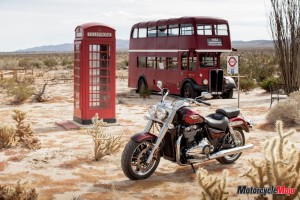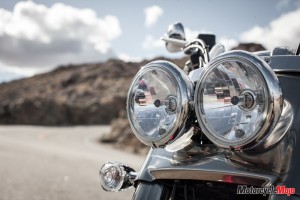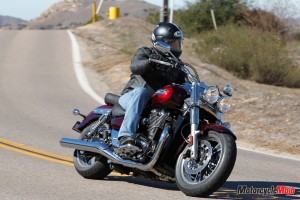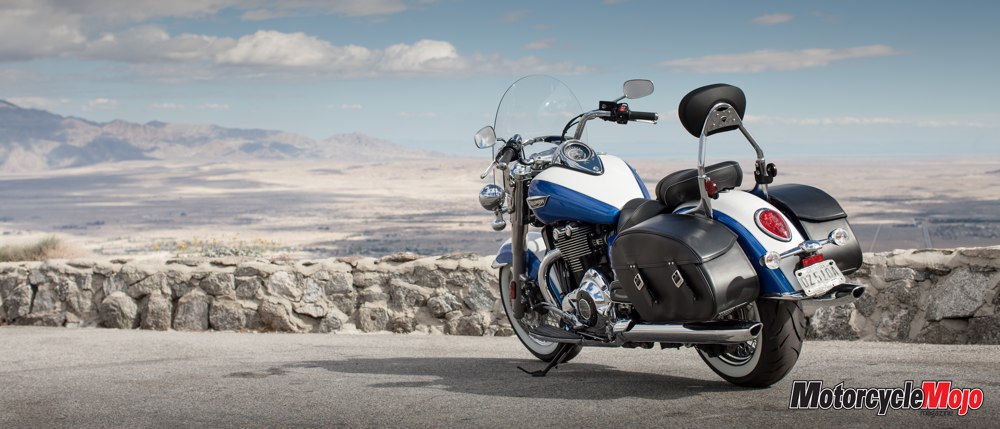Triumph may have been late jumping into the cruiser pool, but they’ve made a commanding statement with a pair of new Thunderbirds
Modern cruisers are a purely North American invention. They were actually developed starting in the late 1970s by Japanese motorcycle makers for the American market, and at the time, they were dubbed “customs” or “specials.” Before that, there was no real cruiser class, though Harley had the chopper-inspired market cornered with the laid-back Low Rider, introduced in 1977. The Japanese began producing these motorcycles, with buckhorn handlebars, stepped seats and laid-back riding positions, to capitalize on this American trend, and it caught on; the cruiser class has grown to dominate the motorcycle market, at least on this side of the ocean.
 One trademark feature of the American cruiser is the V-twin engine, and each of the Big Four has at least one variation of this engine in its line-up. Even European companies jumped on the cruiser bandwagon, including Ducati (remember the ill-fated and long-forgotten Indiana?), Moto Guzzi and BMW.
One trademark feature of the American cruiser is the V-twin engine, and each of the Big Four has at least one variation of this engine in its line-up. Even European companies jumped on the cruiser bandwagon, including Ducati (remember the ill-fated and long-forgotten Indiana?), Moto Guzzi and BMW.
Triumph was a latecomer to the cruiser party, originally introducing the aptly named America in 2002, breaking from cruiser tradition by using the Bonneville parallel-twin engine. But let’s face it, there’s no replacement for displacement, and at 865 cc, by cruiser standards, the America was and remains a lightweight.
Enter the Thunderbird. Introduced in 2009, it featured an all-new, 1597 cc,
liquid-cooled twin, which got a larger bore and grew to 1699 cc with the introduction of the stripped-down Thunderbird Storm in 2011. It is this larger version of the parallel-twin that powers two new variations of the Thunderbird, the Commander and Commander LT. These are not just T-birds with a bunch of goodies bolted onto them; they are new motorcycles with a revised undercarriage that includes, among other things, a different frame, suspension and wheels, and an increased emphasis on touring comfort.
Steering geometry is less relaxed, with a steeper rake angle and less trail than the Thunderbird, to improve handling and steering feel, although the wheelbase has been stretched by 50 mm to 1665 mm, which adds some room for the passenger. The frame has been lowered in the midsection, so the Commander uses 30 mm more seat foam to achieve the same 700 mm seat height as the Thunderbird. The seat is a unique design, including a separate bolster insert designed not to pull down when a rider is seated, thus providing added lumbar support. After a day in this saddle at the launch of the new Commanders in San Diego, California, I can attest that it is one of the best cruiser saddles I’ve perched my backside in, nearing the comfort levels of a true touring-bike saddle. I got equal time on each bike, riding the LT on the first day and the Commander on the second day.
 The riding position is decidedly relaxed and upright, and Triumph refreshingly installed floorboards instead of forward-mounted foot pegs, offering a chair-like stance and allowing you room to move your feet around; the only limiting factor is at your left foot, where the heel portion of the shift lever limits rearward movement, though if you don’t mind scuffing the toe of your boot, it can be removed.
The riding position is decidedly relaxed and upright, and Triumph refreshingly installed floorboards instead of forward-mounted foot pegs, offering a chair-like stance and allowing you room to move your feet around; the only limiting factor is at your left foot, where the heel portion of the shift lever limits rearward movement, though if you don’t mind scuffing the toe of your boot, it can be removed.
When seated, there’s no mistaking either of the Commanders for anything but plus-sized cruisers, and the ultra-wide gas tank puts a lot of real estate between your knees. Although they are hefty machines, the Commander weighing in at 348 kg and the LT at 380 kg wet, their weight sits low and the bikes remain easily manoeuvrable at low speeds.
The main differences between the Commander and Commander LT are that the latter is equipped for light touring duties (hence the LT suffix). For $1,000 more than the Commander, the $17,999 LT includes standard-issue driving lamps, a quick-detach windshield, leather saddlebags (each with 26 litres capacity) with removable waterproof liners, and passenger floorboards and backrest. The LT also uses different wheels and tires, rolling on unique, 16-inch whitewall radials mounted on spoke wheels. The Commander rolls on lower-profile, 17-inch radial tires mounted on cast wheels.
 My test LT was equipped with a taller accessory windshield, which is an option if you prefer looking though the screen. I don’t, but when combined with the accessory wind deflectors, it did provide excellent wind protection with no buffeting.
My test LT was equipped with a taller accessory windshield, which is an option if you prefer looking though the screen. I don’t, but when combined with the accessory wind deflectors, it did provide excellent wind protection with no buffeting.
Although the engine looks nothing like a V-twin, from the saddle, the cadence of its 270-degree crankpins makes it sound and feel like a big Vee, and it produces copious torque, seemingly as soon as the starter gets it fired. Claimed output is 93 hp at 5400 rpm with torque peaking at 111 ft-lb at just 3550 rpm. It chugs away smoothly and doesn’t shudder, even when being lugged at unnaturally low speeds. Clutch effort is relatively light for such a massive machine, but the shifter requires a firm nudge up or down to change gears, though there’s plenty of passing power without the need to row through the six-speed gearbox.
With its low centre of gravity, it’s no surprise that the Commander is an easy-handling machine, and it displays remarkably neutral steering, rolling into a lean effortlessly and maintaining a line almost telepathically. By cruiser standards, Triumph got the handling right on these mega-cruisers. This applies to both the Commander and the LT, though because the stripped-down Commander is lighter and rolls on 17-inch wheels, it exhibits more assured feedback. The taller-profile, 16-inch tires introduce a slight flex into the LT chassis, mostly noticeable when transitioning through ess bends, where a very slight weave resonated through the frame, a phenomenon entirely absent on the Commander. Of course, the limiting factor when riding though twisties is the limited cornering clearance, determined by the floorboards. Triumph cleverly included replaceable inserts that prevent you from damaging the floorboards, which will ultimately touch ground even at a modest pace.
These Commander twins have me a bit befuddled. I’m not a cruiser rider, but I do enjoy riding them – not all riding, after all, is meant for scraping knee sliders – and rolling gently through the countryside on occasion has more than its share of merits. And as a cruiser, there’s little to fault with the Thunderbird Commander and LT. But, there’s a caveat, and that is that these machines do everything they’re supposed to exceptionally well. So well, in fact, that they fit the cruiser mould to a tee. And therein lies my dilemma. Triumph has always been a brand apart for me. They do sportbikes differently, they make those wonderful Bonneville classics in various flavours from café to scrambler, and more recently they’ve entered the adventure-touring arena, again distinguishing themselves from the others in that genre by being the only company to use an inline-triple.
The Thunderbird Commander and Commander LT, competent as they are and unique as they appear, feel like metric cruisers, seemingly lacking that unique Triumph essence that flavours the company’s other machines. Visually, the parallel-twin engine gives the bike some sense of individuality, but when riding it, the Commander just blends into the typical cruiser formula. Triumph making a cruiser for the North American market is akin to Stetson producing an Ascot cap for the United Kingdom; you know it’ll be a quality piece of headgear, but something will most likely be lost in the translation. The Commander is a great cruiser; it’s just not a great Triumph.




































